Communications, Life Safety, and Security Systems in Buildings
Chapter 12 of Mechanical and Electrical Systems in Buildings
Authors Rick Oertli, Bob Kramer, Michael McNeil
Published 2001 by Prentice-Hall, Inc.
COMMUNICATIONS, LIFE SAFETY, AND SECURITY SYSTEMS ARE part of the numerous auxiliary electrical systems which use electrical power to generate, process, store, or transmit information. Thus auxiliary electrical systems are also considered information systems.
The scope of auxiliary electrical systems in buildings is growing at a very rapid pace. What was considered a luxury or state-of-the-art technology only a few years ago could easily be a minimum requirement in newer buildings. For example, a major office building built to operate into the twenty-first century should be equipped with data, communications, security, television, cable, closed circuit TV (CCTV) and/or satellite TV (SATV) systems, in addition to the traditional telephone, sound, signal, building automation, and fire alarm systems. Provisions should be made for raceways and/or wires if some of these systems will not be installed initially.
With the advances in existing technology and the introduction of totally new technology, it is unreasonable to expect architects or the building systems design engineers to be fully cognizant of all available auxiliary systems, even though they may be expert in one or more of these systems. This chapter introduces only the scope and operating principles of some major auxiliary systems frequently required in modern buildings. Appendix A includes acronyms and abbreviations of basic terms with which a professional, regardless of his or her area of specialization, should be familiar. Some of these terms are discussed in the body of the chapter, and the others are explained in Appendix A.
12.1 FORM AND FUNCTION OF INFORMATION SYSTEMS
According to Davis and Davidson,(2020 Vision, 1991) all information can be expressed by one or more forms and functions. There are four forms and four functions:
Forms
• Data numbers, quantitative values
• Text written language
• Sound voice, signal, or music
• Image video, motion or still
Functions
• Generation creating information into various forms
• Processing editing, calculating, analysing, synthesizing, expanding, interpolating, or extrapolating information
• Storage keeping, filing, or memorizing information for retrieval
• Transmission sending or receiving information
As illustrated in Figure 12-1, a basic telephone system is an information system that transmits sound, and only sound (one form and one function). A more sophisticated telephone system can encompass the transmission and storage of data, text, sound, and images (four forms and one function). The interfacing of a telephone system with computer technology adds processing capability (four forms and two functions. Finally, the networking of the computer, telephone, and telecommunication systems completes all four forms and four functions. As science and technology continue to advance, the time will come when the intelligence level of information systems approaches or even surpasses that of humans.
All information systems can be expressed by their forms and functions.
(a) A telephone system generates and transmits sound.
(b) A phone with an answering machine generates, transmits, and stores sound.
(c) A phone with a fax also stores text and transmits data, text, and images.
(d) A desktop videoconferencing with an answer and a fax machine adds images to its form and function.
(e) A computer-phone interface adds processing capability.
(f) The networking of computer and telecommunications can perform all forms and functions.
(g) The ultimate information systems will increase in intelligence until they may supersede that of human beings.
12.2 COMMON CHARACTERISTICS OF AUXILIARY OR INFORMATION SYSTEMS
Several characteristics common to all systems are helpful in planning building systems:
1. Auxiliary systems do not require heavy electrical power. The power demand of most auxiliary systems is normally less than a few kilowatts. In many, it is as low as a fraction of a watt.
2. Most auxiliary systems operate on 30 volts or less, either AC or DC. These systems are frequently described as low-voltage or extra-low-voltage systems. At this voltage level, wiring may be installed without raceways, although raceways or cable trays are often used to facilitate installation and to avoid tampering.
3. Auxiliary systems do not require a large space for equipment. The required space is easier to accommodate than that required for electrical power and HVAC systems. Except for operating consoles and signal devices, equipment may be located anywhere in a building with little effect on overall system performance. Whenever practical, it is desirable to centralize all equipment in head-end rooms to facilitate maintenance of the equipment.
4. Manufactured products usually contain proprietary features. It may thus be desirable to bid these systems as separate packages or on a performance basis.
12.3 CLASSIFICATION OF AUXILIARY SYSTEMS
There are two major groups of auxiliary systems:
1. Communication systems
• Audio public address, intercom, music, radio, etc.
• Video TV, CCTV, SATV, etc.
• Telephone public private exchanges (PAX, PBX), etc.
• Data modem, local area network, wide area network, etc.
• Signals time, program, signals, etc.
• Multimedia combination of audio/video/telephone and data, such as video-conferencing and distance learning systems.
2. Building operational systems
• Safety fire alarm, sprinkler alarm, emergency evacuation, etc.
• Security access control, intrusion detection, etc.
• Automation BAS, BMS, BMAS, etc.
• Specialty sound masking and systems unique for special building occupancies such as hospital, defense, retail stores, food services, theatrical, etc.
12.4 COMPONENTS AND WIRING
12.4.1 Basic Components
Most auxiliary systems operate on DC circuitry, because DC devices are more sensitive than AC. The current drawn could be in the level of milliamperes (1/1000 A) or microamperes (1/1,000,000 A). The following components are common to most systems.
Power Supply Unit
The power supply unit consists of electromagnetic transformers to transform a utility AC system from 110/220 V to less than 30 V. The AC circuit is then rectified into DC by a solid-state device known as diode or silicon-controlled-rectifier (SCR). Figure 12-2(a) illustrates the voltage transformation and rectifying circuitry of most auxiliary systems.
Sensing and Signaling Devices
Most auxiliary systems detect, control, or amplify variations in energy, such as sound, light, motion, temperature, color, infrared, ultraviolet, heat, microwave, and other forms of low-level energy, and convert these forms of energy into electrical energy to operate signaling devices, such as speakers, telephones, clocks, and lights. Increasingly, this energy is converted and controlled with semiconductors or solid-state materials.
A semiconductor is usually defined as a material that has an electrical resistance between that of a conductor, such as metal, and an insulator, such as plastic. Semiconductors are, in general, crystalline materials containing varying degrees of impurities. Silicon and germanium are the most popular semiconductors. Others include copper oxide, selenium, and cadmium sulfide. Semiconductors conduct electricity because of the presence of free electrons in them. Semiconductors may carry negative charges (n type), positive charges (p type), or both (p-n junction type). These types form the various semiconductor devices and circuits, such as thyristors (silicon unilateral switches) and rectifiers (SCRs).
Control Devices
Control devices are manufactured to provide on-off, variable-output (voltage or current), maintained or momentary contact, mechanical or electronic, direct or remote-controlled switching functions. Associated with switching are the necessary relays, circuit boards, and signal and sensing devices.
• FIGURE 12-2
(a) A typical full-wave rectifier circuit consists of a transformer and two diodes. The output is a pulsating DC varying voltage having the same frequency as the AC power supply. (source: Radio Shack: Building Power Supplies.)
(b) The upper diagram illustrates how a telephone voice signal is sampled at four equal intervals and converted into four eight-bit digital signals to represent the original analog input in millivolts. The lower diagram illustrates the conversion in reverse at the receiving end. (Source: Stephen Bigelow, Understanding Telephone Electronics, Prentice Hall Computer Publishing, Indianapolis, IN.)
(c) Typical unshielded twisted pair (UTP) cable. Generally, a 2-in. to 6-in. twist is used. For high-speed data transmission, a tighter twist less than 1 in. is required.
(d) Typical shielded twisted pair (STP) cable with metallic shield and a separate ground wiring.
(e) Typical coaxial cable.
(f) Illustrated at the left is a typical four-pair UTP cable, and at the right is a typical four-pair STP cable. Multipair UTP and STP cables are made in sets of up to 24 or more pairs. In all of the illustrations of cable, the sizes are enlarged for clarification. In general,
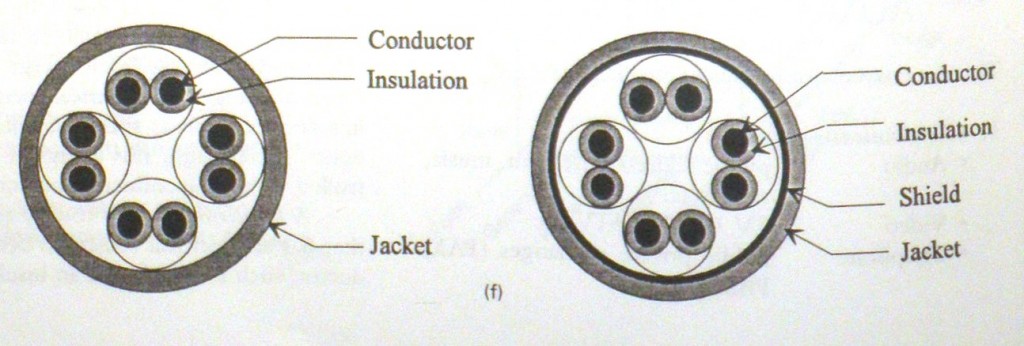
the conductors of UTP, STP, and coaxial cables are made with AWG no. 20 to no. 24 copper wires. The external diameter of the cable depends on the construction of the cable, as well as its shielding, insulation, and jacket thickness. A four-pair shielded cable may have an overall diameter of 0.25 in. (Courtesy: The illustrations of cable are provided by Berk-Tek, Inc., New Holland, PA.)
12.4.2 Wiring for Auxiliary Systems
Line voltage (110 volts or higher) wiring for auxiliary systems follows the same guidelines as other wiring systems for power, lighting, and equipment discussed in Chapter 13. However, most auxiliary systems operate on low voltage and with limited power. Thus, the wiring system will not be a life or fire hazard. Low-voltage wiring is, therefore, normally installed without traditional raceway but typically will utilize open cabling supported by bridle rings, cable tray, or similar methods.
12.4.3 Basic Wiring for Low-Voltage and High-Frequency Systems
One of the characteristics of low-voltage systems is low signal strength. This is particularly true of telecommunication systems, such as voice (telephone), sound (music), radio, and video (TV) signals. The power levels of these systems are usually measured in milliwatts or microwatts; thus the systems are very sensitive to external disturbances, such as electromagnetic interference. The transmission wiring is evaluated according to the following characteristics.
Characteristic Impedance
Most telecommunication systems operate at much higher frequencies than do power systems. Power systems operate at 60 to 400 Hz, whereas telecommunication systems operate in the kilohertz (103), megahertz (106) or gigahertz (109) ranges. At these high frequencies, it is extremely important to match the impedance of the transmission wiring to that of the terminal equipment to minimize the loss or attenuation of the signal. The term characteristic impedance is used to express the performance characteristics of the wires. It relates more to frequency than length. Typical impedances of low-voltage wires for high-frequency telecommunication systems are rated between 50 and 300 ohms.
Transmission Capacity
The transmission capacity of a medium is measured differently for different types of signals. Analog signals are continuous waves. Telephone and TV signals are typically of this variety. The transmission of an analog signal is measured by the bandwidth of the signal, in hertz. The bandwidth may be defined as the highest frequency that can be transmitted in a given medium without excessive attenuation. Typically, the upper limit is specified as the point at which the signal’s strength has dropped by 3 dB. The wider the bandwidth, the higher the frequency a medium can serve.
The bandwidth of a wiring system is limited not only by the construction of the wires, but also by mechanical components (connectors, jacks, patch panels, etc.), by imperfections in wiring, and by effects of the environment (heat, moisture, proximity to power and other signals, etc.).
Digital signals are separate on-off pulses. Data, telephone, and computer signals are transmitted in digital format. The speed of transmission of digital signals is measured in bits, megabits, or gigabits per second. It should be obvious that a 100 megabit-per-second (MB/S) wiring system can carry as much information as a ten 10-MB/S system. The one drawback of digital transmission is the increased bandwidth required to transmit digital pulses compared with the bandwidth required for equivalent analog signals. A major advantage of digital transmission is the fidelity of the generated signal, which is relatively independent of the distance over which the signal is transmitted.
Analog and digital signals can be converted from one to the other. For example, the telephone network converts analog signals (the voice from the telephone handset) into digital signals for long-distance transmission and then converts the signal back to analog form on the other end. For a telephone system containing signals up to 4000 Hz (4 kHz), scanning (or sampling) is made at twice the frequency (8000 times per second). With a seven-bit code that contains the values from 0 to 127, the result is a very realistic reproduction of the voice waveform. With 8000 samples per second and a seven-bit-per-second digital rate, the speed of data transmission is 7 x 8000, or 56,000 bits per second. For high-fidelity speech or music, the sampling rate is usually four times faster, or 32,000 samples per second and 224,000 bits per second. (See Figure 12-2 (b) for a graphic illustration of analog and digital signals.)
There is no precise equivalence between the digital and the analog transmission capacity of a medium. An approximate equivalency exists between 10,000 bits per second of digital capacity and 10 MHz analog capacity.
Basic Wiring Systems
There are three choices for wiring low-voltage and telecommunication systems: twisted pair, coaxial cable, and fiber-optic cable.
Twisted pair (TP) wire is the most commonly used type of wire and is constructed as shown in Figure 12-2 (c). TP consists of a pair of insulated wires, generally copper, twisted around each other, with the length of the twist–the lay—-selected to reduce interference from external electrical and magnetic fields. TP is normally constructed with an outer jacket for physical protection. Additional protection against external fields is afforded by installing an overall shield (a metallic tape or braid), as shown in Figure 12-2 (d). These two types of TP wiring are referred to as unshielded twisted pair (UTP) and shielded twisted pair (STP), respectively.
UTP and STP have been used for many years in such applications as voice communications (telephone and public address systems), control systems (low-voltage lighting, building management, fire alarm, systems, etc.), low-speed digital signals in direct digital control (DDC) building management systems, and short-haul computer communications. The recent proliferation of computers and the demand for high-speed digital transmission have resulted in significant improvement in UTP and STP performance (bandwidth), permitting their use in applications requiring rates as high as 1 gigabit per second. According to the Telecommunication Industry Association (TIA)/Electronics Industry Association (EIA), UTP cables are further divided into six classifications—categories 1 through 6 and enhanced category 5, corresponding to increasing performance and permitting the selection of wiring appropriate to the application and the budget. As of this writing, the standards committee has just adopted the category 6 standard and a new category 7 committee has been formed.
Coaxial cable is constructed as shown in Figure 12-2 (e). It consists of two concentric conductors sharing the same axis (hence the name), separated by an insulating material and surrounded by an overall protective jacket. (Harsh environments may necessitate two or more layers of protective jackets.) The center conductor is almost always solid wire, while the outer conductor is braided or metallized tape. Although the outer conductor has an appearance similar to the shield in STP, it is in fact a current carrier and affords no shielding properties.
RGB Cable
This type of cable consists of four or five coaxial cables in a single jacket. It is typically used for high-resolution analog video signals such as computer graphics to an LCD data projector or a CRT-type data projector. The video signal is broken down into its component parts (red, green, blue, hoz. sync., and vert. sync.), with each coaxial cable carrying a single component.
12.4.4 Fiber Optics
Fiber optics is a technology that uses light as a medium to transmit information or data. Transmitting medium is typically constructed of thin filaments (strands) of glass wires through which light beams are transmitted. For illumination, light may be in any part of the visible spectrum. For data transmission applications, light must be a single wavelength in order to be totally reflected (refracted) within the fiber.
A fiber-optic system consists of many components, including the light source, transmitter, receiver, repeater, regenerator, optical amplifier, and cable, as well as accessories. To transmit light at low loss and for flexibility, optic fiber cables are made of fine fibers about 100 to 200 microns in diameter. The cable consists of a glass fiber core coated with a thin layer of glass or plastic as cladding and covered with one or more layers of material for dielectric isolation and physical protection. (See Figure 12-3 (f).)
Since optic fiber must be very thin (or small in diameter) in order to keep the light within the angle of total reflection, the light source must be very tiny. It has been found that semiconductor lasers or LEDs are the best sources. In addition, lasers at near-infrared wavelengths can keep loss at a minimum in long-distance transmissions. The popular laser and LED light sources are generated from gallium (Ga), aluminum (Al), and arsenic (As) compounds. A wavelength of 750 to 900 nm (1 nm = 10-12m) is used for low-cost, short-distance applications, in which the typical light power loss is about 1.5 to 2.5 dB/km. A 1300-nm wavelength is used for medium-distance applications, in which the typical light power loss is about 0.35 to 0.5 dB/km. A wavelength of 1500 nm is used for long-distance applications, in which the typical light power loss is about 0.2 to 0.3 dB/km.
* FIGURE 12-3
(a) Refraction of a light ray at a plane surface causes bending of the incident ray and displacement (D) of the emergency ray. Snell’s law of refraction is expressed as
n1 sin i = n2 sin r,
where n1 = index of refraction of the first medium
i = angle of incidence (angle the incident ray forms with the normal of the surface)
n2 = index of refraction of the second medium
r = angle of refraction
(b) As the angle of incidence increases, the light ray bends more and more. The angle at which time the reflected ray is parallel to the surface is called the critical angle (ic). A light ray incident at any angle greater than the critical angle is totally refracted (or reflected) back to the medium.
(c)With angles of incidence greater than the critical angle between the glass core and its glass (or plastic) cladding, a light ray is totally reflected, but scattered. This phenomenon is called pulse dispersion.(Top illustration.) Light incident with a lower acceptance angle (bottom illustration) has a low pulse dispersion and thus a higher speed of transmission. (Source: Preceding illustrations reproduced with permission from IES Lighting Handbook, Illuminating Engineering Society of North America.)
(d) This simple schematic diagram shows an optical transmitter and receiver connected by a length of optical cable in a point-to-point link. The transmitter converts electronic signal voltage into optical power, which is launched into the wire by an LED, a laser diode, or a laser. At the photodetector point, either a positive-intrinsic-negative (PIN) or avalanche photodiode (APD) captures the light pulses for conversion back into electrical current. (Source: Belden Wire and Cable Co., Richmond, IN.)
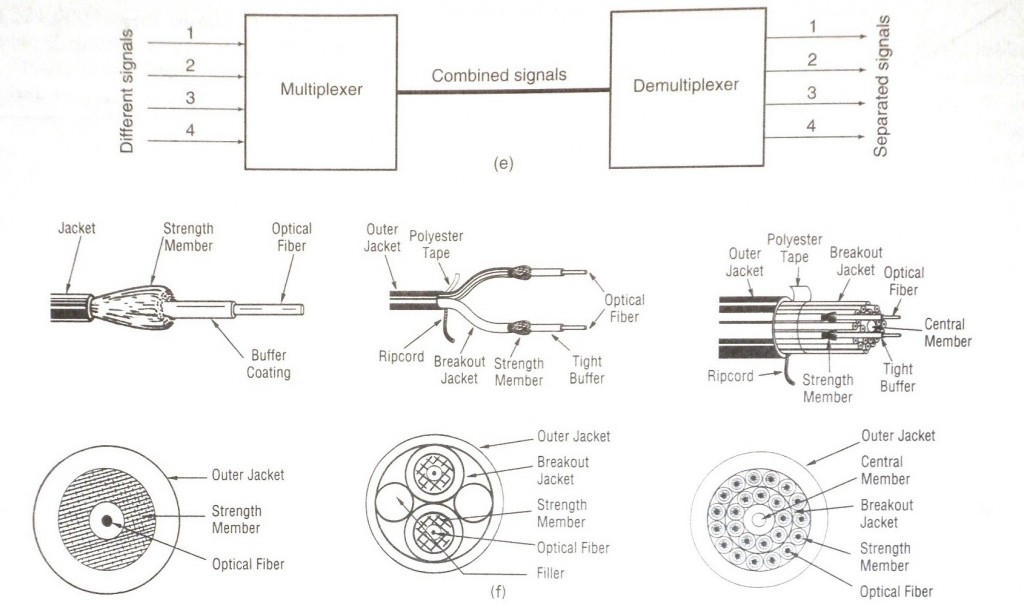
(e)Several signals can be combined or multiplexed into a single signal through a device called a multiplexer. The combined signal is then transmitted through a single transmission line, which greatly increases the capacity of transmission. A demultiplexer at the receiving end separates the signals into their original forms.
(f)From left to right: Construction of fiber-optic cables. Left: single fiber, tight buffer; center: two fibers, tight buffer; right: 24 fibers, tight buffer. The fiber size varies from 50 to 100 microns. (Source: Belden Wire and Cable Co., Richmond, IN.)
The transmitter is used to convert electrical signals into light signals. The electrical signals may be in digital format (e.g., computer data) or analog format (e.g., TV and radio). Light transmission can accommodate either type of signal. In general, digital signals can tolerate distortion, whereas analog signals are subject to disturbance. The operating speed of a fiber-optic transmitter is measured by its bandwidth for analog signals and data rate for digital signals.
The receiver does the opposite of a transmitter, converting light signals into electrical signals. Repeaters, regenerators, and amplifiers are used to reinforce a signal or to minimize attenuation in long-distance applications.
Finally, connectors and splicers are used to make connections and splices in fiber-optic cables. A secure and square connection with low dimensional offset is extremely important. The most widely accepted connector designs are the ST, SC, and the FDDI types. (See Figure 12-4)
Light Transmission Within Transparent Fiber
As an electromagnetic wave, light travels in a straight line. It can be deflected, however, by reflection from a surface or by refraction at the boundary or interface between glass and plastic. The degree of deflection or bending depends on the refractive indexes of the two media and the angle at which the light strikes the interface (boundary) between two media. See Figure 12-3(a). If light within the medium with the higher index hits the boundary with the medium with the lower index at an angle smaller than a certain critical angle, the light beam will be totally refracted within the medium. This is known as total reflection (it is no longer described as refraction). See Figure 12-3(b).
A fiber used in fiber optics is a hair-thin, all-glass filament. It consists of two solid portions—the core and the cladding, which are inseparable from each other. The light travels through the core, while the cladding keeps the light contained within the core because of its different refractive index.
* FIGURE 12-4
During earlier years of fiber cable development, each cable manufacturer often developed its own design for connecting or splicing cables. This leads to the problem of interfacing between equipment and systems. To eliminate the proliferation of connector designs, the International Standards Organization (ISO) and the Telecommunications Industry Association (TIA) have endorsed the square connector type SC, the round connector type ST, and the fiber distributed data interface(FDDI) connector as preferred standards. Configurations of these connectors are shown in (a), (b) and (c). (Courtesy: Jeff Hetch, Understanding Fiber Optics, Sams Publishing, Indianapolis, IN.)
Conversion of Electromagnetic Waves
Since light and electrical energy are all part of the electromagnetic spectrum, they differ only in wavelength and frequency. Light and electrical energy can, therefore, be converted from one form to another. This unique property becomes a great asset in modern communication technology when electrical signals in either analog or digital form are converted into light signals for low-loss transmission through a tiny optic fiber and then are converted back to electrical signals for processing. See Figure 12-3 (d). Furthermore, many signals may be transmitted simultaneously within the same fiber, a process known as multiplexing. See Figure 12-3 (e). In practice, a complex fiber optic cable can transmit thousands of signals. With the proper light source (an LED), cable construction, and channels (pulse dispersion), a multimode fiber optic cable may transmit several millions of digital signals simultaneously.
Fiber Optic Multiplexing Methods
Sending multiple signals over a single fiber optic cable can be accomplished utilizing one of three methods: time division multiplexing (TDM), wave division multiplexing (WDM), and dense wave division multiplexing (DWDM). Synchronous optical networking (SONET) is a good example of TDM over fiber. (See Table 12-1, optic cable level versus line rate.) Utilizing TDM, speeds up to 10 gigabytes per second (Gbps) are possible.
TDM equipment breaks up the available bandwidth into “time-slots.” These time slots are then rotated through the various signals at a given rate. For example, suppose that you are multiplexing four separate signals (A,B,C,D). A TDM sequence might appear as follows; A-B-C-D-A-B-C-D-A-B-C-D-A-B….
WDM takes multiplexing even further. Utilizing WDMs, up to 28 TDM signals can be multiplexed together. A WDM takes each signal but does not sequence the signals; instead, different colors of light are used for each signal to be transmitted. These signals are on 6-nm centers and are multiplexed through a prism. This technology allows the signals to be transmitted independently of one another. DWDM technologies are just now emerging, and these multiplexers promise to allow transmission of signals on subnanometer increments. This would allow thousands of simultaneous signals resulting in terabits of bandwidth.
Advantages and Application of Fiber Optics
The primary advantages of fiber optics technology are its high transmission capacity and low loss characteristics. In addition, electromagnetic interference or moisture does not affect fiber optics. Some typical applications of fiber optics are the following:
* Long-distance telephone lines, on land and at sea
* Local and wide area networks
* Cable television between microwave receivers and head-end equipment
* Transmission of a signal where moisture may be a problem.
* Transmission of signals where electromagnetic interference is a problem.
* High-security applications, such as financial, military, and intelligence systems
12.4.5 Selection of Wiring Systems
The selection of wires and cables among twisted pairs, coaxial cables, optic fiber, and combinations thereof depends on the application, the performance of the medium in terms of bandwidth, transmission speed, attenuation, impedance, shielding, etc., and, of course, the cost of installation of the wires and cables. Optic fiber is best as regards bandwidth and speed, but it is the most costly of the three media. However, the cost gap is steadily closing. Optic fiber is now being installed in backbone wiring in buildings and in local and wide area networks. For design and installation guidelines, the EIA and TIA standards listed in the reference section of this chapter are the best resources.
Table 12-2 lists the basic applications of the popular transmission media and the ranges of speed at which they may be used. As with the design of any building system, the future needs of the building and trends in technology must be carefully weighed in the selection of wiring systems for all electrical auxiliary systems.
12.5 TELECOMMUNICATION SYSTEMS
A telecommunication, or telecom, system is defined as any electrical system that transmits, emits, or receives signals, images, sound, or information of any nature by wire, radio, video, or some other form of energy within the electromagnetic spectrum. Thus, telephone, radio, microwave, radar, intercom, public address, CCTV, broadcasting TV, and SATV are all telecom systems. Telecom technology is changing so rapidly that a new system may become obsolete within a few years. Thus, this section discusses only the general concept, without dealing with specific design data or guidelines.
12.5.1 The Electromagnetic Spectrum
The electromagnetic spectrum is a graphic representation of radiant energy in an orderly arrangement according to its wavelength or frequency. Radiant energy within the spectrum differs in wavelength and frequency, but its speed of transmission is constant. The speed of radiant energy in vacuum is 299,793 kilometers per seconds (km/s), or 186,282 miles per second (mi/s). The speed of radiant energy in air is slightly slower (299,724 km/s). In round numbers, the speed may be considered to be 300,000,000 m/s (3 x 10^8 m/s). The following equation expresses the relationship among speed, frequency, and wavelength:
s = f x G (12-1)
Where s = speed, 3 x 10^8 meters/seconds (m/s)
f = frequency, cycles per second (cps or hertz)
G= wavelength, meters (m)
Example 12-1 The standard frequency of electrical power in the United States is 60 HZ. What is the wavelength of the electrical power?
Answer: The wavelength of 60-Hz power is 3 x 108/60 = 5 x 106m.
Example 12-2 If the radio frequency of an FM station is 100 MHz, what is the wavelength?
Answer: The wavelength of the FM radio is (3 x 108)/(100 x 106) = 3m.
12.5.2 Standard Radio and Video Frequencies
The region of radio and video frequencies within the electromagnetic spectrum extends from 3 kHz to 300 GHz. (One GHz is 1 billion Hz.) The boundary of each subdivision of a region is gradual; there are no specific demarcation lines.
To minimize interference between transmitted signals, the applications of frequencies are strictly controlled by governments. The regulatory agencies in the United States are the National Telecommunications and Information Administration (NTIA) of the U.S. Department of Commerce and the Federal Communications Commission (FCC). Table 12-3 lists some typical applications of FCC/NTIA standards to power, radio, video, and radar signals. The governments of all developed and developing counties also control their transmission frequencies. In general, the frequencies allocated by other countries are comparable to those used in the United States, forming the basis for international standards.
12.5.3 Audio and Video Systems
Audio and video (A/V) systems refer to radio and TV systems that receive their electromagnetic signals “off air” (on the air), cable networks, or signals generated locally, such as tapes or compact disks. This section discusses systems that receive and transmit off air only.
Exterior Antennas
An antenna is a device for receiving or transmitting off-air A/V signals. Although most A/V equipment—e.g., radio or TV—has built-in antennas, heavy concrete or steel building walls and roofs attenuate these signals to the extent that they are often distorted or noisy. In most buildings, exterior antennas are necessary to ensure good reception of the signal.
An antenna on or near a building has a major impact on the aesthetics of the building. The designer must be keenly aware of the size and location of the antenna during the design process, so that these elements may best be coordinated with the overall design, rather than be added as an afterthought. This is particularly important for buildings such as hotels and offices, which are increasingly dependent on satellite data transmission.
The ideal location of an exterior antenna is on the roof of a building or in an open space on the ground. Antennas should be mounted in such a manner that there is no major obstruction between the antenna and the transmitted signals.
External antennas come in all shapes and sizes. Some popular models are the yagi type (straight bars) for VHF frequencies, loop type for FM/UHF frequencies, and dish type for satellite frequencies. Figure 12-5 (a) illustrates a typical radio and VHD antenna. Higher-frequency UHF signals are more directional. Their behavior is close to that of visible light, which travels in a straight line but can be reflected by a reflector or focused by a parabolic-shaped dish. Figure 12-5 (b) illustrates a typical dish-type antenna.
If outlets are limited in number and in distance, as in a residence, the strength (gain) of a signal from an outdoor antenna should be sufficient without further amplification. On the other hand, larger buildings having tens or hundreds of outlets will require additional head-end equipment to filter, boost, convert, amplify, modulate, and combine the various frequencies into a total distribution system. When the signals are combined, the distribution from the head-end equipment to the individual outlets can be accomplished by a single coaxial cable looping between outlets, rather than with multiconductor cables. The economic benefit is obvious.
Telecommunication Satellites
Most telecommunication satellites are of the geostationary type, in an orbit 22,300 miles directly above the equator. The satellite maintains the same relative position and attitude with respect to the earth by the use of small station-keeping jets. The electrical power required to operate these jets is obtained from batteries recharged by photovoltaic solar collectors.
The satellite itself is an assembly of many receivers and transmitters, with associated amplification. Each satellite is designed to cover certain areas on the earth. The signal is weaker at the edge of an area, and as the site of the receiving station moves further from the equator, the size of the receiving station is increased to compensate. In other words, a satellite dish is made considerably larger in Alaska than in Florida in order to receive signals from the same transmitter. The angle of the receiving station is lower the further it is from the equator.
The speed of the signal is the speed of light. This means that there is a minimum known delay in the signal of at least the time it takes to travel the 22,300 miles between the receiver/transmitter and the satellite, or 0.24 second. The further from the equator the receiver/transmitter is, the longer is the distance to cover, and the greater the reduction in signal strength and the lower the angle of the receiver/transmitter. This lower angle makes it more probable that obstructions will be encountered. Processing time at the satellite (to turn the signal around) usually makes the transmission time approximately 0.4 second, or 400 ms, or greater.

Satellite Receiver/Transmitter for Building Services
A satellite receiver/transmitter installed for building services is referred to as a VSAT, which stand for very small aperture transceiver. A transceiver is a combination transmitter and receiver. The dish portion of the device is a section of a parabola. The focal point concentrates the incoming signal at the receiver for amplification at the horn. The alignment of the dish is critical for reception and transmission of the signal to the satellite.
The angle and azimuth necessary to acquire the satellite signal are known from any location that can “see” the satellite. The viewing angle must be clear. Although it is possible to acquire a signal through deciduous trees, this situation should be avoided, since obstruction will attenuate the signals.
A VSAT ranges from 1 m up to 10 m in diameter. The size required depends on the altitude and longitude of the building and the satellites. With the advance of technology, antenna dishes have diminished drastically in size in recent years. Smaller antenna terminals with more powerful amplifiers are being developed. The diameter ranges from about 1 ft for ultra SAT (USAT) to less than 1 ft for tiny SAT (TSAT). Associated with the reduction in size are an increase in frequency and transmission speed and a narrowing of the beam pattern.
Signal Distribution
Each of the signals (frequencies) received is processed by a separate controller that is connected to the A/V and VSAT antenna by coaxial cable. The allowable distance between the antenna and the controller is limited and varies with the total configuration. Figure 12-5 (c) is a schematic diagram of an A/V satellite signal distribution system in a large building.
12.6 DATA DISTRIBUTION SYSTEMS
Data distribution through networking is no longer limited to major facilities, such as computer centers, hospitals, hotels, department stores, and corporate headquarters. Any building or group of buildings equipped with central computers, remote terminals, or multiple units of PCs should consider installing a data distribution system. With the continuing improvement in networking technology, and with lower costs, it is conceivable that a data distribution system will be installed even in most homes in the near future.
The biggest advantages of networking are that it allows the sharing of files, programs, and equipment and that it saves money. Networking also makes it easy to set up an electronic mail (E-mail) system or establish a shared connection to the Internet. With the proliferation of the Internet over the last several years, the demand for Internet access has grown as well. The “Net” is penetrating our lives from almost every angle and provides access to a wealth of information. With data sharing, data need be entered only once, thus eliminating the wasted effort of reentry of the data at each station. Data networking has become as common as telephone cabling. Most commercial and educational buildings are cabled with category 5 or enhanced category 5.
12.6.1 Types of Distribution Systems
When different pieces of equipment are connected to distribute data or files to each other, the equipment is said to be connected as a network. The data to be distributed are usually in a digital format, although they may be in analog format as well. Networking may be confined to within a building or may be extended to thousands of miles away.
Local Area Network
A local area network (LAN) is a system that connects computers and peripheral equipment within a building or within several nearby buildings for the purpose of sharing resources. A LAN system is practical within several thousand feet. Thus it is applicable to campus-type facilities, such as universities, corporate headquarters, and industrial complexes.
LANs are made up of servers, workstations, and PCs. The server needs a faster processor and a larger hard disk than the workstation does. Each workstation that is to be connected to the LAN requires a network interface card (NIC). The card is the interface between the network electronics and the workstations. There are many network adapter cards, such as ATM, Ethernet, (10-base-T, 100-base-T, 1000 base-T), ARCnet, Token Ring, FDDI, and Zero-Slot LANs.
LAN Topologies
The physical layout of a LAN is called its topology. The most common LAN topologies are as follows:
- Point to point is the simplest format, connecting one server and one workstation.
- Star topology is an extension of point-to-point topology to multiple workstations. This topology is most-commonly used in LAN applications.
- Bus topology has one cable connecting all the workstations and the server. This is the topology of Ethernet LANs.
- Ring topology is similar to a bus network, except that the ends are tied together to form a ring. This is the topology of IBM Token Ring LANs.
- Switchboard topology is an arrangement in which each workstation is considered its own network segment. This increases speed by dedicating bandwidth rather than sharing resources.
Star topology consists of home-run cabling from each node back to a central point of connectivity, or hub. The hub maintains whichever logical topology is the basis for the structured cabling system in buildings defined in the TIA/EIA, 568: “Commercial Building Telecommunications Wiring Standard.”
In a ring network, the cabling between nodes forms a ring. In an Ethernet network, the cabling between nodes forms a bus. Figure 12-6 (a) through (c) illustrates the physical topologies of data distribution systems. Figure 12-6 (d) is a block diagram of a combination data, telephone, and A/V system.
FIGURE 12-6
(a) Star LAN is arranged around a single hub. The hub can be simply a passive coupler or an active controller. This is the preferred arrangement for all LAN installations. (b) Ring LAN is linked point to point. A bit pattern (token) is circulated to each node (workstation or peripheral equipment), to control the data transmission. (c) Bus LAN uses carrier-sensing multiple access with collision detection to control data transmission. (d) LAN wiring diagram incorporating telephone, computer, and A/V links with multiple- and single-mode fibers as risers (backbone) and twisted pair or coaxial wires for equipment connections. (Courtesy: Belden Wire & Cable, Richmond, IN.)
Wide Area Network
A wide area network (WAN) is defined as a data communication network that uses common carriers lines to extend a LAN beyond the building or campus its serves. WANs typically transmit over phone lines, microwave towers, and satellites without limitation.
Virtual Private Network (VPN)
One increasingly common variation of a WAN is known as a virtual private network (VPN). In a VPN, by each node of the WAN has a connection to the Internet. Then, by secure protocols, a “free” connection is made between sites. Applications running on the network operate as if a dedicated circuit connected the sites. Depending on the number of remote sites and connection speeds, savings of up to 75 percent can be realized by utilizing VPN technology.
Wireless LANs
Data and A/V signals may be transmitted through a wireless network, which usually operates on infrared or radio frequencies. This type of technology can transmit information at relatively high speeds, but a clear line of sight is needed between the receiving and transmitting devices. Its major advantage is flexibility: systems can be expanded without prewiring. It is usually more costly initially but may be less expensive in the long run. Wireless LANs are limited to smaller systems. Another disadvantage of wireless LANs is the possibility of external interference with the signal. The infrared system is susceptible to interference from light sources, from the radio frequency, and from electromagnetic sources.
12.6.2 Design Considerations
Structured wiring is wiring that is used to coordinate the multimedia transmission of data, voice, and video signals. A plan for the installation of structured wiring should cover seven design elements:
- Entrance facilities, i.e., conduits, manholes, and armored cables
- Equipment rooms, including construction and space requirements
- Telecommunication closets, particularly their locations and sizes
- Backbone wiring, including risers and the infrastructure
- Horizontal wiring, i.e., wiring between backbone and workstations
- Work area
- Administration
Specific recommendations for each design element are given in EIA/TIA Standard No. 568. When the recommendations are followed faithfully, they will ease network administration and enhance computerized tracking and documentation, as well as minimize attenuation of the signal. The wiring recommended for backbone and horizontal distribution includes 100-ohm UTP, 150-ohm STP, 50-ohm coaxial cables, and 62.5/125 micrometer optical fibers.
Wiring within a building for a LAN is usually made with twisted-pair or fiber-optic cables. The selection depends on the type of data to be transmitted. For high-speed transmission and broad bandwidth, optic fiber is preferred at a higher cost. (See Table 12-2 for the applications of telecommunication cables.)
Cables are best connected and terminated at one or more wiring closets distributed strategically throughout the building, preferably not more than 300 ft apart.
Wiring for (digital) data distribution systems may be combined with (analog) A/V and telephones systems when the proper interface devices are provided. (See Figure 12-6 (d) for a typical wiring diagram of a combined data, telephone, and A/V system.)
12.7 SECURITY SYSTEMS
A security system installed in a building safeguards people and property. Security systems range from manned security guards at building entries or exits to sophisticated monitoring and alarm systems. This section addresses the latter systems only.
12.7.1 Types of Systems
Basically, a security system interfaces various access controls, annunciations, alarms, communications, and information-processing components. A security system may itself be interfaced with other building management systems, such as fire alarm, public address, and building automation systems. Modern security systems are invariably computer systems with logic chips, programmable controllers, and/or central processing units. The fundamental components of a security system are as follows.
Intrusion Controls
Security starts at the property line with fences or walls that may or may not incorporate electrical surveillance. Electrical surveillance usually operates on infrared (active and passive), acoustical (audible and ultrasonic), microwave (beam pattern and field effect), or vibration detection principles.
Access Controls
An access control system identifies the person seeking to enter or leave a building. The techniques include the following:
- I.D. cards, which may incorporate magnetic strips, proximity-tuned passive circuits, coded pattern capacitors, infrared optical masks, or mechanical (Hollerith) coded holes arranged in a pattern.
- Biometric identifications, which make use of several unique physiological characteristics of a person, such as fingerprints, a retinal scan, hand geometry, a signature, or a voice print. Of these characteristics, fingerprints and eye retina identification are the most reliable and are thus desirable for high-security applications.
- TV camera in a CCTV system. With a camera, visual recognition is relatively simple, and it is economical for small or medium-sized facilities. However, it would not be practical to use only a camera in large facilities, where hundreds or thousands of people must be recognized by the security personnel. Nonetheless, a camera works very effectively in conjunction with other methods of identification.
Detection Within the Building
Sensing devices are installed in corridors, stairs, elevators, and critical spaces. Among these devices are:
- Motion detectors, which utilize infrared, microwave, or capacitance principles.
- Photoelectric detectors, which generate a light beam between the photocell and a receiver. If the beam is interrupted, a signal will be initiated.
- Electrical contacts, which may be either normally closed or normally open. When the positions of the contacts are disturbed, the circuit will be activated. Typical applications of contact devices are doors and windows.
- TV cameras, as a part of the CCTV system.
Annunciation
When the detection devices are activated, the security system should announce the event at strategic locations in the building. Commonly used devices include:
- Computer alarm monitoring station.
- Alarms—bells, horns, buzzers, etc.
- Annunciators, i.e., lights and lighted panels with locations identified.
- TV monitors, as part of the CCTV system.
- Speakers, which interface with the building’s public address or intercom system.
- Digitized voice messages.
- Wireless radio system, which interfaces with the building’s radio communication system.
Recording Information
All security-related activities should be recorded through a computer-based printer or file to register the sequence of events.
12.7.2 Closed-Circuit Television
Closed-circuit television (CCTV) is a wired self-contained television system. Although it is widely used in security applications, it is also used in industrial process controls, business promotion, sports training, traffic controls, experimentation, data filing, etc.
A basic CCTV system consists of an electronic camera that converts an optical image into analog signals, a transmission medium (usually coaxial cables or fiber optic), and a monitor to convert the signal back to an image. The signal is stored on tape or compact disk through a videorecorder, multiplexer, or video printer. The system may be expanded into a multiple camera, monitor, and recorder system. A CCTV system may have one or more of the following features:
• Mode. Black-and-white or color; continuous, sequential switched, or time-lapsed monitoring; or multiplexed recording which allows 4 to 32 cameras to be recorded on a single VCR.
• Cameras. Fixed position or pan/tilt/zoom (PTZ); sensitivity to normal or infrared spectrum; freeze action; remote controls.
• Monitors. Single or multiple units; full or split screen; various sizes of screen; various resolutions (300 to 1200 lines per screen).
• Recorders. Videocamera recorders; time lapse recorders; sequential switches; time-date generators or digital computer-based recording.
Figure 12-7 (a) shows the various CCTV components, and Figure 12-7 (b) shows the connection diagram of a system with a multicamera, time-lapse videotape recorder, sequential switching, and a date generator. In practice, CCTV systems are usually interfaced with other systems into a combined security system. See Figure 12-7 (c).
12.8 TELEPHONE SYSTEMS
Since the invention of the telephone in 1878 by Alexander Graham Bell, telephony has become the primary means of communication in modern societies. The level of development of a nation or a region can often be judged by the number of telephones installed per capita.
Telephone services are usually provided by public utilities, which may be owned by private enterprise or the government. With the exponential development of new telephone technology, such as cellular telephone systems, private branch exchanges (PBX), wireless telephones, pagers, personal communication services (PCS), and facsimile (FAX or fax), the planning of telephone systems in a building has become more complex. Often the advice of the public utility or an independent telecommunication consultant is necessary if a new facility is to have state-of-the-art capabilities.
The fundamental principle of a telephone system is very simple. The system starts with individual telephone sets, a central switching or exchange facility, a DC power supply, and distribution wiring in between. The traditional telephone set consists of a transmitter, a receiver, a ringing circuit and switching and coding devices. The transmitter is in effect a microphone, and the receiver is a speaker. When a person talks into the transmitter, the acoustical (sound) energy compresses a carbon-granule-filled diaphragm, causing a change in its electrical resistance, which in turn varies the electrical current (at the milliampere level) through the loop circuit to the receiving party’s telephone. The receiver then converts the electrical current back into acoustical energy. Figure 12-8 (a) illustrates the construction of a traditional telephone transmitter.Nowadays, transmitter/receivers are increasingly the electrodynamic type utilizing the principle of mutual inductance between electricity and magnetism; see Figure 12-8 (b). The electret type utilizes the property of electrostatic charge on a coated dielectric diaphragm. Vibration of the diaphragm will change the electric voltage and current in the loop circuit. With amplification, the signal is transmitted to the receiving telephone; see Figure 12-8 (c).
For long-distance transmission, the analog voice signals are converted into digital signals so that they may be integrated with other digital signals utilizing multiplexing technology. The quality of new telephone systems is improving steadily, to the point that long-distance conversation over thousands of miles away is just as clear as if it were next door. With the emergence of new network-based telephone systems, it is not unusual to achieve full CD-quality voice communication.
Some mobile and cellular telephone systems operate on narrow radio frequency bands. (See Table 12-3 for their operating frequencies.) The signals are currently transmitted from closely spaced transmitter towers to cover a defined area. The technology will most likely migrate to satellites and eliminate the costly local transmission towers.
12.8.1 Types of Systems
Telephone services are provided directly by the telephone company. There are two types of dialing systems: pulse-tone (a rotary dial) and touch-tone (a push-button keypad). The latter is a newer technology that can interface with digital signals. It offers many more features, such as data transmission, voice mail, and fax, that are not easily achievable with the pulse-tone system. A touch-tone telephone has 12 push buttons (0 to 9 plus, and 1). When pushed, each button generates two tones, one low-frequency tone between 697 and 941 Hz and one high-frequency tone between 1209 and 1477 Hz. This feature, known as dual-tone multifrequency (DTMF), is designed to prevent false signals.
A private branch exchange (PBX) is a private telephone system serving one building or a group of buildings. A PBX system connects to the public telephone system through a switchboard or automatic switching equipment. The switchboard may or may not require an operator. The abbreviation PBX is used interchangeably with PABX, which stands for private automatic branch exchange, since current PBX systems are all of the automatic type. Most PBX systems have direct outward dialing, a feature whereby one dials “9” to connect to the public telephone trunk line. A PBX system can be interfaced with computer systems. Figure 12-8 (d) illustrates a PC-based PBX system. Some typical features of a PBX system are the following:
- Ancillary device connection
- Automated attendant
- Automatic call distribution
- Automatic redial
- Automatic trunk-to-trunk traffic
- Call forwarding
- Call transfer
- Call holding
- Call privacy
- Conference calls
- Code restriction
- Customized messaging
- Delay announcement
- Direct inward dialing
- Direct outward dialing
- Speed dialing
- Intercom
- Fax interface
- Hot line
- Key/multifunction registration
- Night answer
- Off-hook voice announcement
- Off-premise extension
- PC programming
- Route advance block
- System/station speed dial
- System data up/download
- Security code (password)
- Toll restrict
- Trunk-to-trunk transfer
- Voice mail integration
- Voice recording service
- Centrex compatibility
- All call
Centrex is a business telephone service offered by the local telephone company. It is basically single-line telephone service with special features, such as intercom, call forwarding, call transfer, and least-cost routing. The advantages of Centrex over a PBX system are Centrex’s lower initial investment, equipment space savings, continuous updating with new technology, and lower level of maintenance. However, the special features are limited, and the service may not be available in many areas.
Facsimile (FAX or fax) is the technology that allows written materials, data, and images to be transmitted through the switched telephone system and printed out at the receiving end. There are five internationally accepted equipment groups: 1, 2, 3, 3E (enhanced), and 4. Group 3 and 3E are the most popular types, with transmission speeds between 9600 and 14,400 bps. Group 4 is designed for digital lines transmitting at speeds between 56,000 and 64,000 bps.
12.8.2 Design Considerations
Wiring for telephone systems need not be installed in raceways. However, for security and aesthetic reasons, all wiring within finished spaces should be concealed. Receptacles should be provided within the telephone closets for equipment. Telephone trunk lines should be terminated in strips in boxes or in telephone closets for splicing and distribution. Figure 12-8 (e) illustrates the distribution diagram of a telephone system. For preliminary purposes, one linear foot of wall or closet space is allowed for each 3000 sq ft of finished floor space.
12.9 FIRE ALARM SYSTEMS
A fire alarm system is not limited to initiating an alarm during a fire; it may also serve to identify the location of the fire, transmit audio or visual messages, activate fire extinguishing systems, and interface with building management systems. A more sophisticated fire alarm system is in effect a fire management system. This section introduces various fire alarm systems and their electrical wiring requirements. See Chapter 9, which discusses planning, detection, and signalling devices commonly used in fire alarm systems.
12.9.1 Code Requirements
The requirements of a fire alarm system and the locations of devices are governed by the National Fire Protection Code (NFPA 72), Americans with Disabilities Act (ADA), and local building codes, which vary with the occupancy, location, size, and height of the building. In general, a fire alarm system is required in public assembly buildings, businesses, educational institutions, hotels, factories, and hospitals. Theaters and entertainment facilities are exempted, as a false alarm may cause panic.
12.9.2 Types of Systems
A fire alarm system is usually a combination of several basic systems. Among these are the following
Central Station versus Local System
The alarm signals are transmitted to a central monitor remote from the building. With modern communication technology, the central station may be miles away from the building, at the fire department or even in another city to which transmission occurs through telephone or modem lines. Local systems are wired completely within the building. A key factor in a reliable fire alarm system is the reliability of the electrical power supply. On-site generators or battery backups are preferred.
Manual or Automatic System
A fire alarm system may consist simply of manual alarm stations connected to sound bells or horns. However, for building use groups that involve the public and for residential buildings over three stories in height, automatic detection devices are usually mandatory. In automatic systems, signals are initiated by automatic detection devices, as well as from manual alarm stations.
Coded or Noncoded System
A fire alarm system may provide the alarm signal continuously until the system is turned off manually. This is known as a noncoded system. By contrast, if the signal is intermittent in duration or frequency, then the system is said to be coded. A coded system is usually designed to produce three rounds of signals to identify the location of the fire or the initiating device. For example, a signal with one short and one long sound may mean that the fire is at the first-floor east wing, whereas a signal with two short and two long sounds may mean that the fire is at the second-floor west wing. A coded system is a necessity for multiwiring or multisectional buildings. The coding may have to be subzoned for large building when it becomes too complex.
Supervised or Nonsupervised System
With a nonsupervised system, accidental grounding or breaking of the wiring or contacts will undetectably disable the system until the problem is discovered. In the meantime, the system is inoperative and the building is unprotected. In a supervised system, the signal notifies the building management of the problem until it is fixed. Supervised or double-supervised systems are preferred in large buildings. Nonsupervised systems are typically not recommended and do not adhere to the NFPA standards and most local codes.
Single or Zoned System
In a single-zone system, all alarms are activated at once; in contrast, a zoned system may divide the alarms into two or more zones according to the locations of the alarm devices. For example, a building with east, center, and west wings may be divided into 3 zones, 1 for each wing. If the building is five stories high, then it may be divided into 15 zones, 1 for each floor of each wing. Caution must be exercised not to overdivide the zones, as the signal may become too complicated to be recognized.
Single-Stage or Two-Stage Systems
With a single-stage system, all alarms within each zone will be energized to signal that the building should be evacuated. Two-stage systems may provide a preliminary warning or alert to the occupants during the first stage and a signal to evacuate the building only when the second stage is energized.
General Alarm of Presignal System
In buildings where a general alarm signalling a minor fire may cause panic and the building is under full-time supervision by qualified personnel, a presignal system may be desirable. With this system, detection devices or manual alarm stations will send the signal only to limited location so that management can determine whether and when a general alarm is to be activated. Schools and stadiums are good candidate for such a system. Note that the use of a presignal system in hospitals is prohibited by the NFPA, unless specifically approved by code officials.
Voice Communication System
Modern fire-signaling systems can also include a public address system to provide instructions to the occupants by the building management and, in later stages, by the fire department. The public address system may also be supplemented by two-way communication devices, such as telephones, intercoms, and radio frequency modules. Speakers may be used to generate a tone in lieu of bells or horns. Voice communication systems are required in all high-rise buildings and public assembly use groups.
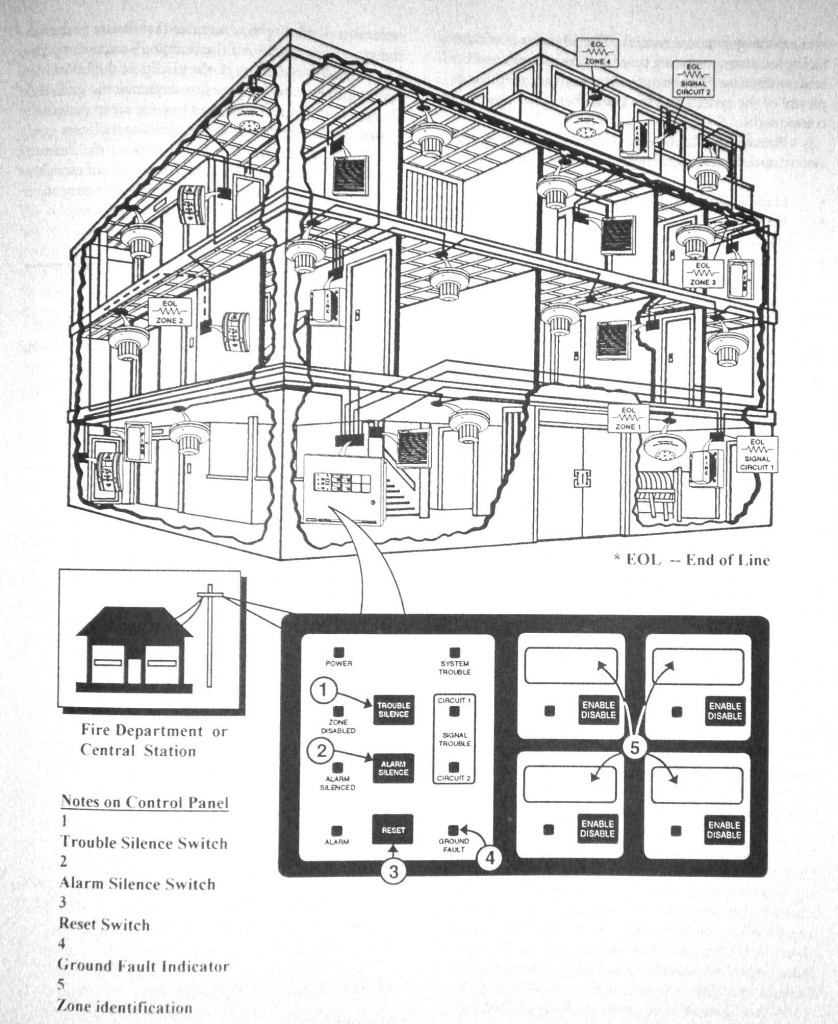 Addressable or Nonaddressable System
Addressable or Nonaddressable System
A system is addressable when each fire detection or signalling device is assigned a unique coded frequency (address). The address may be adjustable to allow reassignment of the field. With this capability, the fire protection plan (zone and staging) may easily be changed to fit a building’s operational program. Addressability is especially useful for a tenant-occupied building when the tenants are frequently changing. Nonaddressable systems do not have this flexibility, but are, or course, more economical. A system may combine addressable and nonaddressable devices through an interfacing device. Figure 12-9 illustrates a typical multizone fire alarm system.
FIGURE 12-9
Small multizone fire alarm system showing the location of the control panel, signal, and alarm devices, This is a four-zone system. Additional zones can be accommodated. (Courtesy: G.S. Edwards/A Unit of General Signal, Farmington, CT.)
Standalone or Integrated System
The fire alarm system may be a standalone system or may be interfaced with other building systems, such as an automatic sprinkler, building management, life safety, and vertical transportation systems. The advantages of interfacing are many, including space and cost savings and better coordination. The primary disadvantages are the complexity of the system and the interdependence among its components.
Thus a fire-alarm system combination may be a system such as the following:
- Manual, single-zone, single-stage system
- Manual and automatic, multizone, noncoded, single-stage system,
- Automatic, multizone, coded, two-stage with presignal and voice communication system
Naturally, a more sophisticated system offers better protection and requires a greater capital investment and more supervision. The selection of a system is governed primarily by the code and determined partially by the evaluation of the specific needs of the building.
12.9.3 Design Considerations
Because of the critical nature of fire signaling and life safety, wiring for fire alarm systems should be in conduits or raceways separate from other, noncritical power or low-voltage systems. Electrical power should be supplied from the emergency section of the power system and, preferably, backed up by an independent power system, such as battery packs or on-site engine generators. Some fire alarm systems can also be provided with power packs.
Fire and smoke detection devices should be located where there is a likely hazard, such as in storage rooms, electrical-mechanical rooms, and public egress areas (e.g., in entrances, elevators, or lobbied, near stairways, etc.). The fire command center where the control panel or the command console is located, should be in a secure locale, constructed of fire walls and, preferably with a direct means of egress.
Audible fire annunciation devices, such as bells, horns, chimes, and tone generators, should have the proper sound power (dB), so that all occupants in the building can hear the signals. On the other hand, too loud a sound may create a deadening effect on the ears, and possible panic. The sound level should be higher than 60 dB at any location, but not higher than 120 dB near the annunciation device. This range is usually the guideline for determining the selection and spacing of such devices.
Visual annunciating devices, such as flashing or strobe lights, should be provided for the hearing-impaired, following ADA requirements.
The fire alarm system should be coordinated with the building HVAC control system so that the HVAC system may operate in a manner that assists in the safe and speedy evacuation of the building’s occupants. This is usually achieved through the efforts of the HVAC design engineer, who attempts to sequence the quantities of supply, return, exhaust, and outside air to maintain a smoke-free environment at the building exitways.
In designing the fire alarm system, the designer should study the feasibility and economics of establishing an integrated fire alarm and building management system that is most appropriate for the building.
12.10 SOUND SYSTEM
Sound systems in buildings normally involve the distribution of voices or music from one part of the building to another. The system may be capable of one- or two-way communication and may be either wired or wireless.
A sound system consists of one or more input devices, such as a microphone, tape recorder, radio, or telephone. The input is converted to electric signals that are amplified and transmitted to output devices, such as speakers or telephone receivers. In broad terms, a sound system is analogous to an amplified telephone system.
Sound systems may be classified into two groups. A public address system is designed to broadcast a voice message, such as an announcement or speech, from one or more locations to other parts of the building. It may carry or mix with other inputs, such as radio, tape background music, or telephone. It is usually a one-way system with output devices that have talk-back capabilities. Public address systems are installed in schools, hotels, department stores, hospitals, industrial plants, and other buildings in which the administration or management can make announcements or transmit music.
An intercom system is a two-way communication system between two or more stations. It may consist of one or more master stations, which can communicate with each other, or slave units, which can communicate only with the master unit to which they are connected. Intercom systems are installed in homes, apartments, offices, and specific departments within a building, such as between the sales area and the warehouse of a store, between offices, and between the lobby and apartment in a multiunit apartment building.
12.10.1 Basic Components
A microphone is an input device that reacts to and converts variable sound pressure (speech, voice, or music) into variable electrical current. The most popular microphones are the condenser type, which operates through changes in capacitance caused by vibrations of its conductive diaphragm; and the dynamic type, which has an electrical coil attached to a diaphragm moving within a magnetic field. A low-cost microphone may have a frequency response range between 50 and 10,000 Hz (the normal frequency range for human hearing), whereas the high-end microphone could extend the range to between 20 and 20,000 Hz. The response to the sound pressure may be very narrow (directional), broad (cardioid), or nondirectional (omnidirectional). A microphone must be selected so as to match the impedance with other components of the system. Figure 12-10 (a) illustrates the internal construction of a dynamic microphone.
Speakers
A speaker is an output device that converts electrical signals into sound signals through electromagnetic voice coils and a driver that vibrates a speaker cone. Speakers are designed to respond to either the full frequency range or tuned
frequencies—that is, bass (a woofer, for low frequencies) or treble (a tweeter, for high frequencies). Speakers are hung from ceiling surfaces, are recessed into the ceiling, or are mounted on the wall. Most speakers are provided with matching transformer and volume controls. Figure 12-10 (b) illustrates several types of speakers.
An amplifier receives a sound-generated electrical signal and boosts the signal for transmission to output devices. Amplifiers for public address systems are from 15 watts to 300 watts of sound power with a frequency response from 20 to 30,000 Hz. They may be self-contained or may be designed to include switches, a radio tuner, tape or compact disks, and a telephone interface. Figure 12-10 (c) illustrates a desktop model of a public address system and its block diagram.
12.10.2 Design Considerations
In designing a building sound system, one should determine the location of a control center where messages are normally initiated and the locations, sizes, and ambient noise levels of rooms to which the messages are to be transmitted. Figure 12-10 (d) is a one-line diagram of a typical public address system.
Next, one must determine the approximate number of speakers required for each space. In general, ceiling speakers (usually 8 in. in diameter) can cover 250 sq ft of floor area at an 8-ft height and up to 600 sq ft at a 12-ft ceiling height. A trumpet (horn) type of speaker may cover 8000 sq ft in large, quiet open spaces; the area of coverage is reduced in noisy spaces.
For planning purposes the power required for different speakers is as follows:
- 8-in. ceiling or single-projection wall speakers 1 watt
- 12-in. ceiling or double-projection wall speakers 2 watts
- Column speakers 10-30 W
- Trumpet speakers 10-30 W
- Signal (ring) generators 2-4 W
The amplifier is sized for the total power of the speakers, plus an allowance for future expansion. To achieve good sound reproduction, it is good practice not to load the amplifier to its maximum rating.
Sound systems are wired primarily with twisted pair or coaxial cables. In conduits or wireways, shielded twisted pair (STP) is preferred.
12.11 TIME AND PROGRAM SYSTEMS
With watches becoming increasingly affordable, the need to indicate the time has diminished drastically in most buildings. However, time and program systems are still necessary in schools, sports facilities, and certain industries where synchronized time is important. Such systems consist of a control center (master clock, code generator, switches, etc.), individual clocks (secondary or slave clocks), program signaling devices (bells, buzzers, or annunciators), and wiring. There are various types of devices for synchronizing time.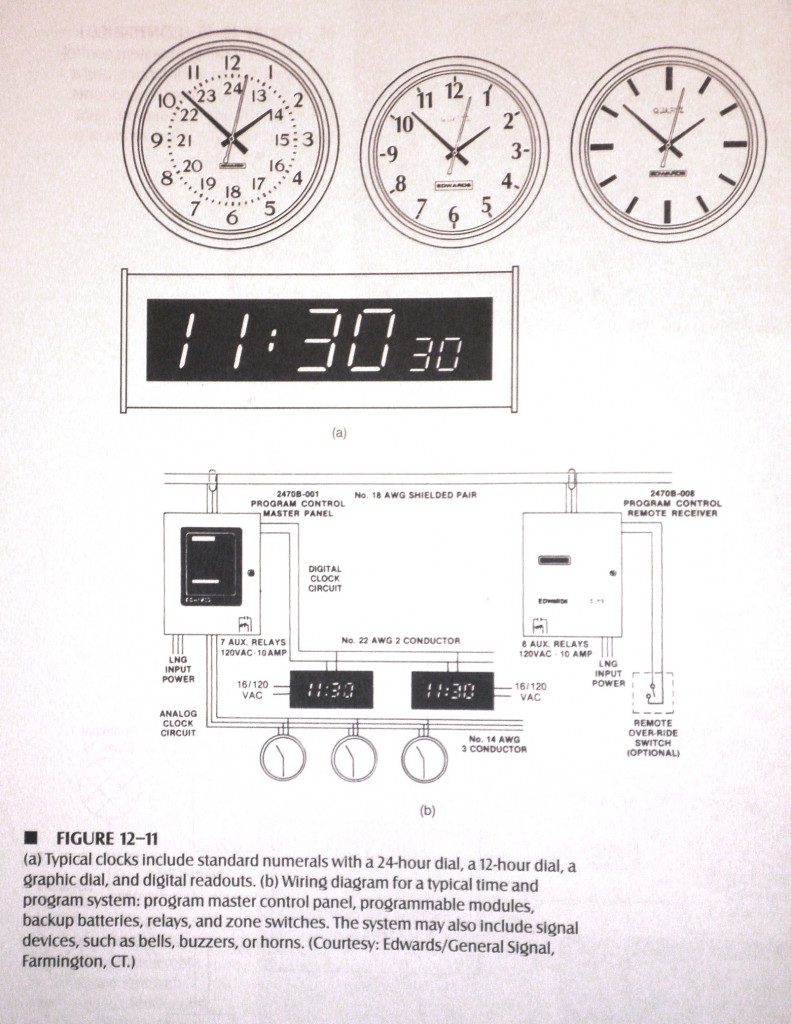
- Synchronous motor-driven type. Secondary clocks and signalling devices are wired to the control center. The secondary clock runs by a synchronous motor, but its indication of time is monitored and adjusted by the master clock.
- Impulse-driven type. Secondary clocks and signaling devices are wired directly to the control center. The secondary clock is driven by an impulse signal of the master clock and advances once every minute in unison with the master clock. During a power failure, the control center will accumulate missed minute impulses for up to 24 hours by its standby battery power. Upon restoration of normal power, rapid correction pulses will be sent to advance the secondary clocks to the correct time.
- Carrier-frequency type. Individual clocks are plugged into the standard 120-volt power without special wiring, but the indication of time is corrected by a high-frequency signal (between 3000 and 8000 Hz) carried (i.e., superimposed) through the 120-V power wiring system. With the carrier-frequency system, dedicated wiring between the control center and the individual clocks (and signalling devices) is eliminated.
- Radio frequency type. The individual clocks are plugged into the standard 120-volt power system without special wiring. The time is corrected by a radio frequency generator. The frequency may be tuned to the National Institute of Science and Technology (NIST) universal time for extreme accuracy in special research applications.
Figure 12-11 illustrates several components and the wiring diagram of a typical time and program system.
Videoconferencing
Videoconferencing systems are becoming more common in business and education. Videoconferencing allows face-to-face meetings and sharing of data without the need for excessive travel, overnight lodging, and other related expenses. A typical videoconference will provide high-quality audio and video utilizing 1 to 3 ISDN lines or several channels of a T-1 service. The local telephone company or other service providers can provide ISDN lines and T-1 service. Videoconferencing can also be accomplished using a LAN or WAN connection over an existing data network; the main advantage of this type of connection (compared with ISDN) is that there are no long distance charges. Each location of a videoconference must be equipped with a basic videoconferencing system:
- Videoconferencing CODEC (code decoder)
- Video monitor
- Video camera (fixed or pan/tilt unit)
- Microphone or microphones
- Connection to ISDN or T-1 service
These components can be grouped on a mobile cart or integrated into a single piece of equipment.
One important consideration for a videoconferencing system is the refresh rate it is capable of providing; 15 FPS (frames per second) to 30 FPS is full- motion video similar to the quality from a television signal; 15 FPS is acceptable but will provide a jagged and jerky picture when movements occurs.
Videoconferencing systems are standards-based systems, which allow most manufacturers’ equipment to work together. The current standards are H.320, which governs the protocols used for ISDN and other public switched network interfaces. H.323 governs the protocols used for videoconferencing over a LAN and WAN connection.
Multimedia Presentation Systems
Multimedia systems are typically found in corporate boardrooms, conference centers, auditoriums, and training centers. These systems can consist of a multitude of audio, video, and control equipment.
- Typical equipment
- LCD Data Projector – used to project video or data onto a large screen for viewing by a large group.
- Document camera – video camera and light table that will allow a document or three- dimensional object to be displayed on an LCD projector.
- Slide to video converter – allows standard 35mm slides to be displayed through LCD projector.
- Projection screen. Typically a motorized Tab-tensioned screen. A tab-tensioned screen provides a very flat projection surface, which is extremely important for viewing computer images such as spreadsheets or CAD drawings.
- Audio system. Consisting of ceiling- or wall-mounted speakers and wireless or tabletop microphones to reinforce speech or program material (audio from VCR tape, etc.) Additionally, a mixer, equalizer, and amplifier are required.
- Controls system – This typically consists of table- or podium-mounted touchscreen panel or a wireless touchpanel. The control system consolidates and automates numerous devices into a single easy to operate panel. For example a single button on the control panel could dim the lights, close the blackout shades, turn on the OCD projector, and lower the projection screen. The operator can then select the source to display (such as the VCR) and then control the transport functions of the VCR.
These types of control panels are fully customizable to allow for expansion and other changes to the system.
12.12 MISCELLANEOUS AND SPECIALTY SYSTEMS
Because of space considerations, many commonly used auxiliary systems have not been covered in this chapter. Nonetheless, they should not be overlooked in the building design. For example, a doorbell system, although very simple, is necessary in many kinds of buildings. In addition, facilities such as offices, apartment complexes, hotels, hospitals, department stores, schools, and entertainment and sporting facilities often have many other unique systems that must be addressed during the initial planning phase of the project. Some of these systems are mentioned here without explanation. They serve as a reminder to the designer that auxiliary electrical systems are becoming more and more important in the building design process. The following list mentions some of these facilities and the systems often found in them:
- Hospitals and health-care facilities. Nurse’s call; doctor’s paging; patient-monitoring systems in intensive care units; bedside monitoring and control panel; telemedicine diagnoses; remote imaging readout; videoconferencing and multimedia conference and educational centers.
- Hotels and motels. Do-not-disturb and room makeup systems; maid call; bedside environmental lighting and entertainment panel; CCTV; front-of-the-house and back-of-the-house management; central reservation and accounting point of sale.
- Sporting and convention facilities. Central lighting controls, scoreboards, CCTV, and videotapes; two-way radios; special open-space fire and smoke (infrared beam); high-power sound reinforcement system.
- Residences and apartments. Door intercom; intrusion and security; wired sound; TV and satellite antenna.
- Department and retail stores. Shoplifting detection systems; general surveillance; point of sales; distribution of TV and satellite antennae, staff-locating systems.
Table 12-4 is a checklist of auxiliary electrical systems that should be considered during the planning of the foregoing facilities.
QUESTIONS
12.1 What are the forms and functions of information systems?
12.2 What are the forms and functions that can be provided by radio? TV? A computer with a modem?
12.3 What is the difference between analog and digital signals? Can they be converted from one to the other?
12.4 Human hearing frequency extends beyond 10,000 Hz. What is the highest frequency that can normally be transmitted by a conventional telephone system?
12.5 What wires are commonly used for telecommunications systems?
12.6 What is fiber optics? What is an optic fiber?
12.7 Name two primary advantages of an optic fiber over twisted pair or coaxial cables.
12.8 What is meant by critical angle in an optic fiber?
12.9 The index of refraction of glass is 1.5 (N1 = 1.5) and the index of refraction of air is 1.0 (N2 = 1.0). What is the critical angle when light passes from glass to air?
12.10 What are the metal compounds commonly used to generate laser in fiber optic systems? What are the range of wavelengths in nanometers (nm)?
12.11 What is the applicable transmission speed range in Mbps for a coaxial cable? A single-mode optic fiber?
12.12 What are the frequency bands assigned for FM radio in the United States? VHF/TV channels (2 to 6)? Cellular telephones? Satellite UHF?
12.13 What is a geostationary-type telecommunication satellite? What is its orbit (miles above the earth)?
12. 14 What is a LAN? A WAN?
12.15 What are the disadvantages of wireless LAN?
12.16 What principles are commonly applied in detecting intrusions?
12.17 What techniques are commonly used in controlling access?
12.18 What detection devices are commonly used within a building?
12.19 What are PBX, DOD, and DID in a telephone system?
12.20 What are the two types of telephone dialing systems?
12.21 What is a coded, a supervised, a zoned, and an addressable fire alarm system?
12.22 Why are flashing or strobe lights required in fire alarm systems?
12.23 What is a public address (PA) system? What are its basic components?
12.24 What size ceiling or wall-mounted speaker is normally used in buildings, and what is the approximate area of coverage?
12.25 What types of wires are normally used for sound systems? Can optic fiber be used?
12.26 What is a time and program system? Where is it usually installed?
12.27 How are clocks synchronized in the time-clock system?
12.28 Name as many as you can of the auxiliary systems which should be considered in a large residence, a hospital, a hotel, and a department store.
12.29 Low-voltage cabling typically does not require traditional EMT conduits. What methods are commonly used to support low-voltage cable?
12.30 When would conduit (EMT) be necessary when low-voltage cable is installed?
12.31 What are the two most common types if data projectors used to display computer graphics?
12.32 RGB cable is typically used for high-resolution video signals. What are the individual video components carried by an RGB cable?
12.33 Name the card installed in a PC workstation to connect it to a LAN or WAN.
12.34 What is the most common type of topography used for a LAN?
REFERENCES
1. NFPA-70, National Electrical Code, National Fire Protection Association, Quincy, MA
2. EIA/TIA 586, Commercial Building Wiring Standard.
3. Jeff Hecht, Understanding Fiber-Optics. Indianapolis: Prentice Hall Computer Publishing, 1993.
4. Harry Newton, Newton’s Telecom Dictionary, 7th ed, New York: Flatiron Publishing, 2000.
5. Stephen Bigelow, Understanding Telephone Electronics. Indianapolis: Prentice Hall Computer Publishing, 1997.
6. Robert T. Paynter, Introductory Electronic Devices and Circuits. Englewood Cliffs, NJ: Prentice Hall, 1997.
7. Lighting Handbook. New York: Illuminating Engineering Society of North America, 2000.
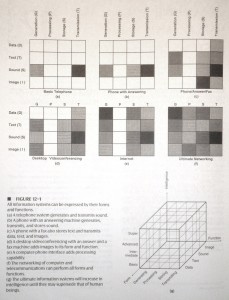

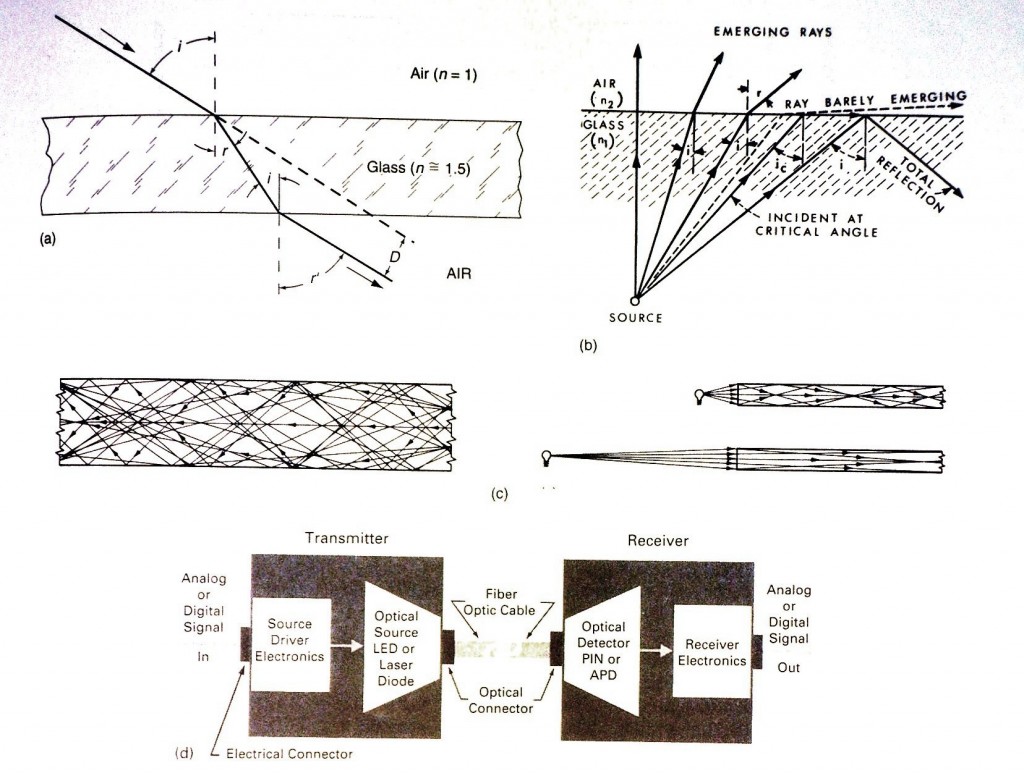
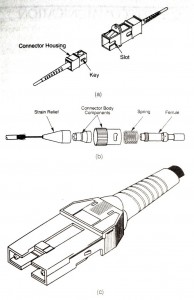
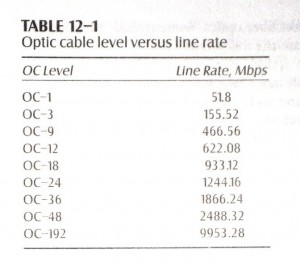
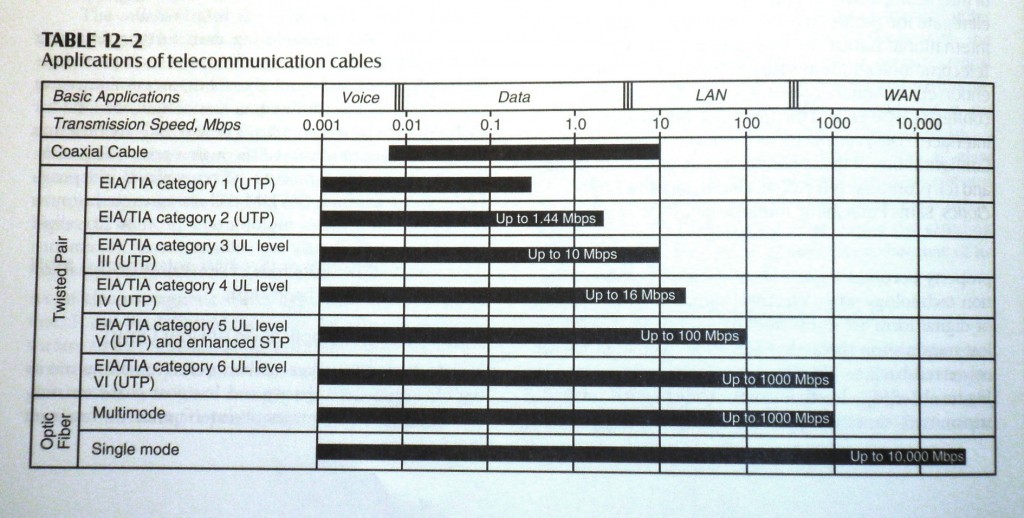
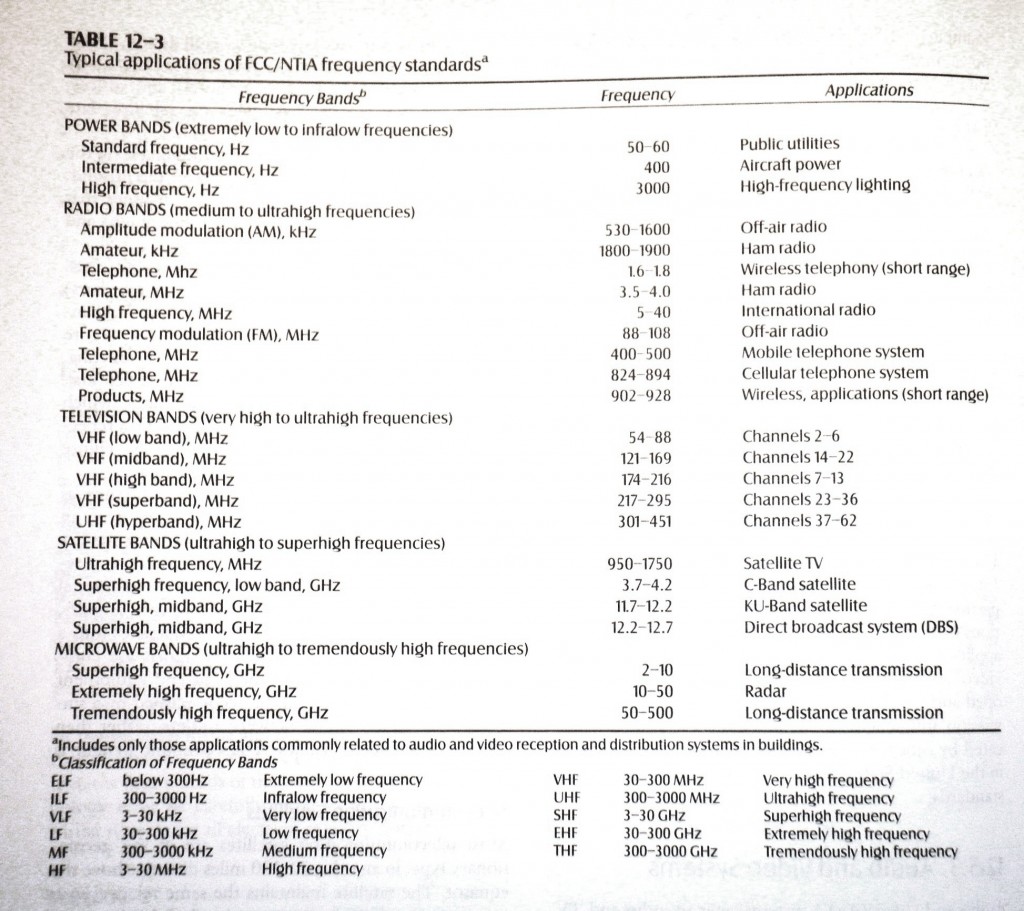
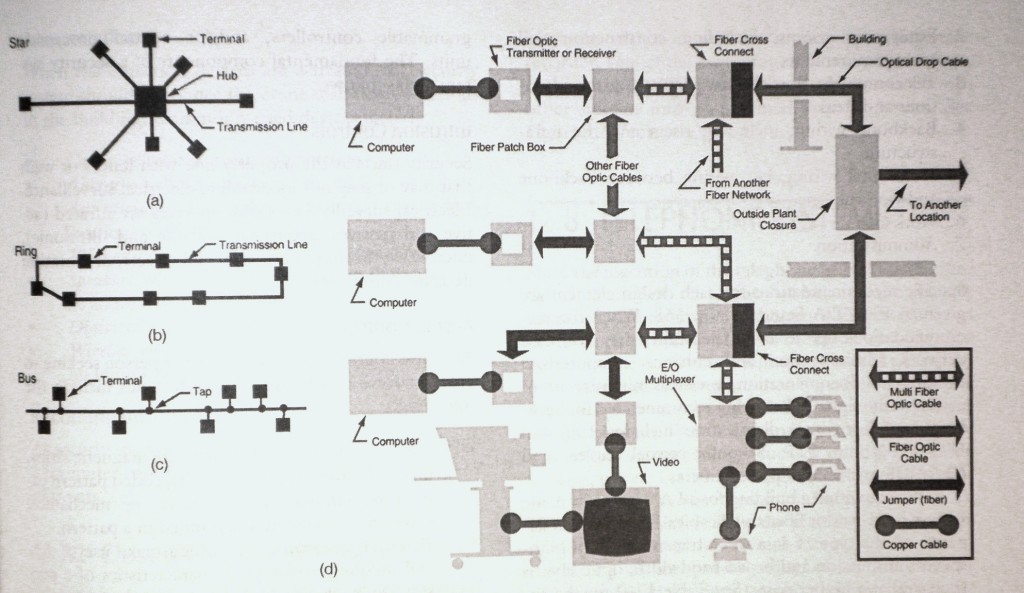
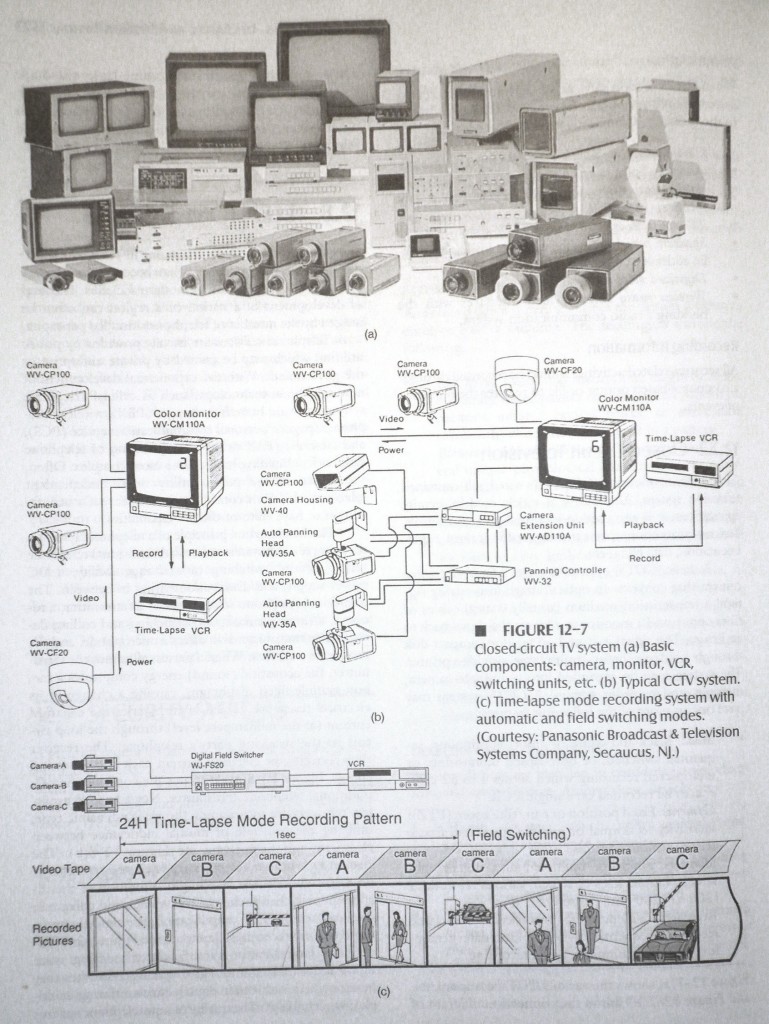
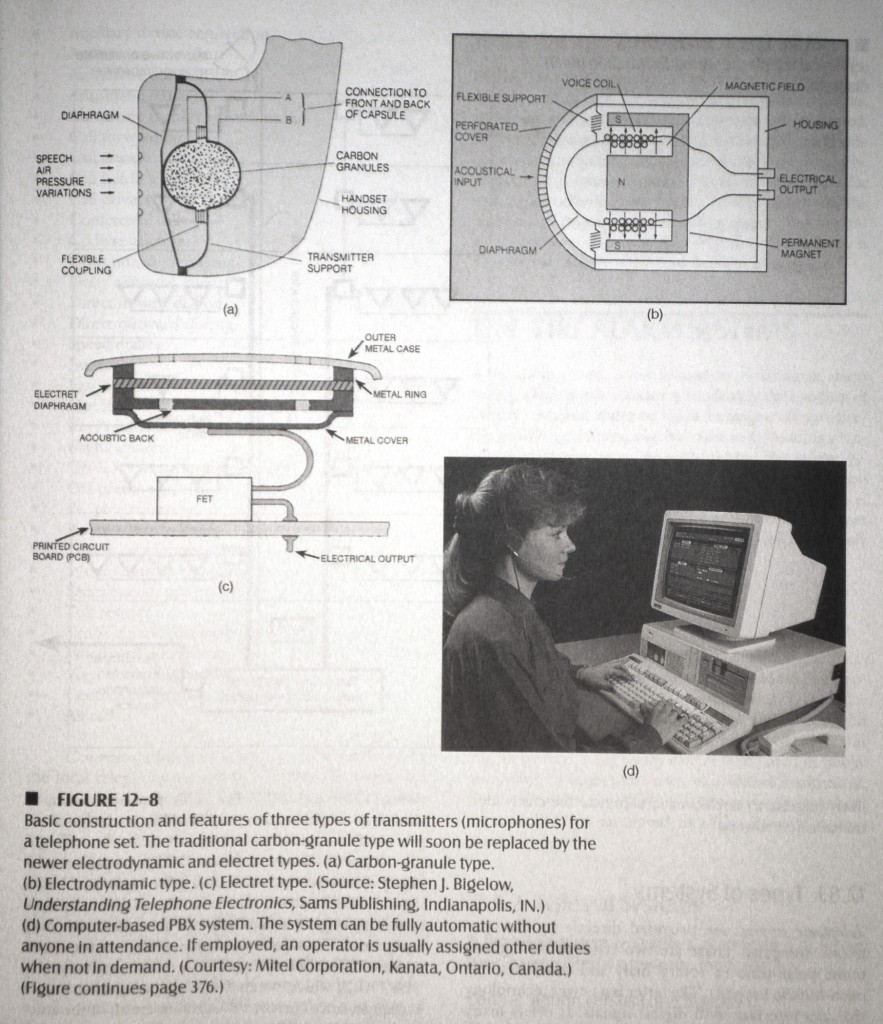
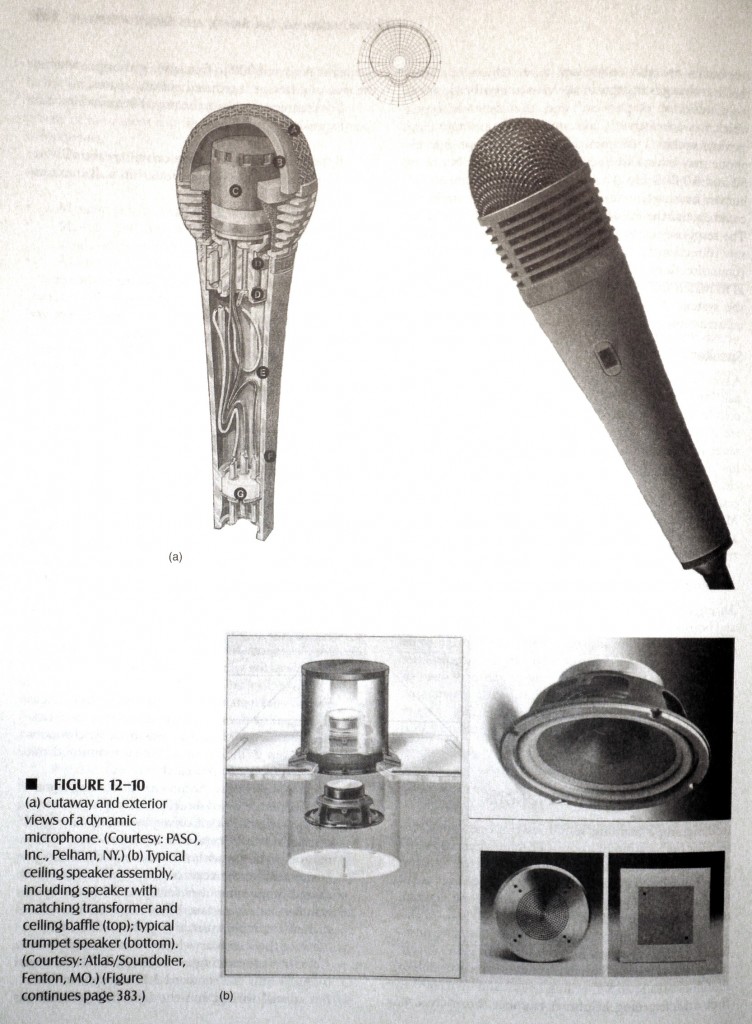
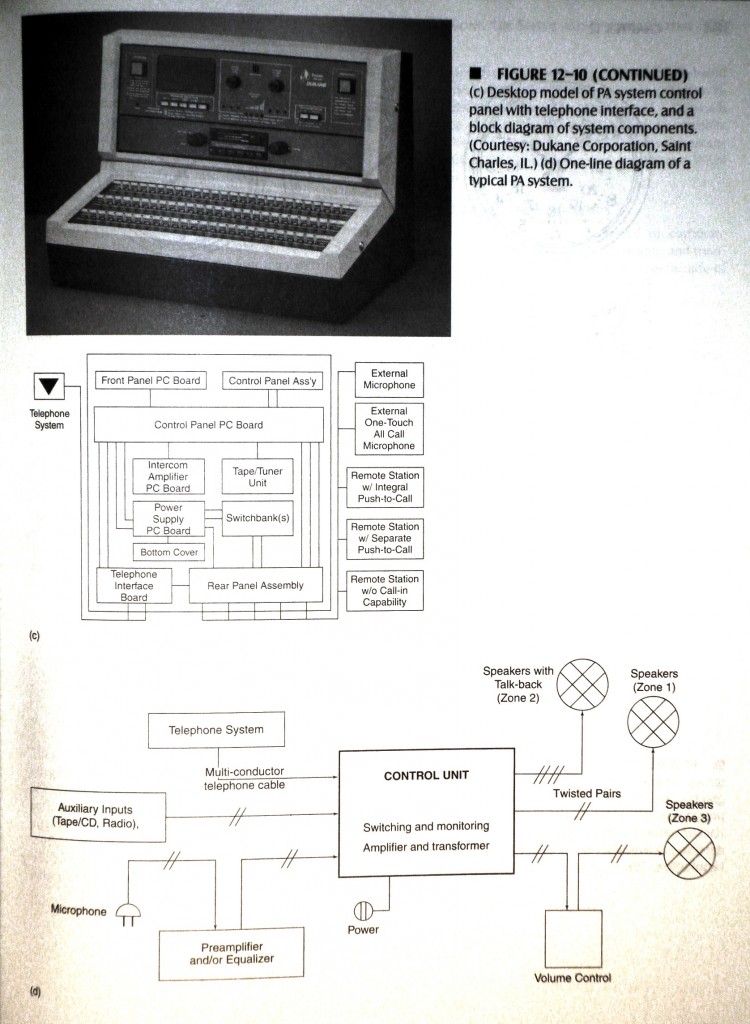
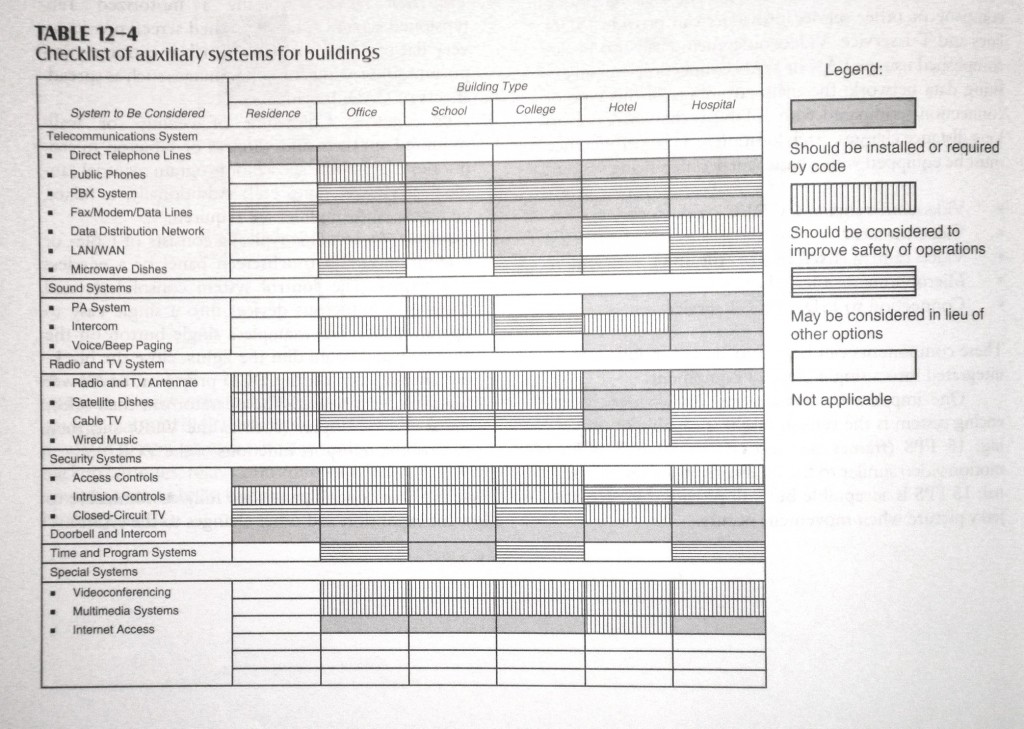
No comments yet.